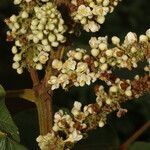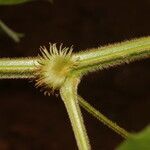Lianas; young stems 5-sulcate, the older stems with 3 broad corky wings; sap milky; wood composite, usually with 3 inconspicuous peripheral bundles; stem, petiole and rachis with sparse long pubescence. Leaves pinnately 5-f oliolate; petioles to 22 cm long, winged; rachis winged, 6-24 mm wide; leaflets elliptic, oblong-elliptic or obovate, usually abruptly acuminate at the apex, obtuse to at-tenuate at the base, 8-30 cm long, 4-12 wide, weakly bullate at least in age, gla-brous above except for the hirsute midrib and the weakly pubescent principal veins, glabrate to hispidulous throughout below, the midrib often both hispid and puberulent, crenate above the middle, the teeth glandular; blades, rachis and petiole with margins ciliate; stipules paired, lanceolate, 2-4 cm long, to 1.5 cm wide, minutely pubescent and ciliate. Inflorescences cylindrical, axillary, stout, ca. 2.5 cm wide, 10-20 cm long, densely rufous-tomentose, bracteolate. Flowers white; sepals to 5.3 mm long, suborbicular, concave, tomentulose, ciliolate; petals equalling or exceeding the sepals, glabrous except for appressed pubescence out-side medially in the lower 2/3 of the petal, the scales 2/3_3/4 as long as the petal and nearly enclosed within the concavity of the petal, the scale margins and margins of the deflexed appendage prominently bearded with stiff, white trichomes, the crest ca. 1 mm long, entire, orange; disc glands of the anterior petals whitish, erect, flattened, broader than high, densely pubescent at the base; stamens 7 or 8, the filaments densely villous throughout, to 3 mm long, held closely together around the pistil, the anthers ovate-elliptic, the connective dark, the thecae whit-ish; staminate flowers with ovary bearded at the base, the 3 styles short and re-duced, held well below the anthers; bisexual flowers with styles 3-branched to below the middle, to 2.3 mm long, held well above the anthers, the unbranched part pubescent. Capsules pyriform, 3-5 cm long, rounded to subcordate and apiculate at the apex, tapered to the base, terete to broadly 3-sided, 3-celled, the valves thick, to ca. 3 mm diam., striate, densely puberulent to glabrous without, glabrous within; seed 1 (rarely 2), to 2 cm long, enveloped throughout by a red mesoderm, the aril apparently lacking.
More
Erect or arching shrub, or liana to 8 m long. Stems obtusely 3-5-angled, glabrous or pubescent, glabrescent, usually producing scarce milky latex; cross section with a single vascular cylinder; older stems trigonous, with 3 corky wings, reaching 2.5 cm in diameter. Stipules oblong, concave, reflexed, persistent, 2-4.5(7) cm long. Leaves pinnately 5-foliolate; petiole and rachis broadly winged, petioles 9-28.5 cm long, rachis 5-8 cm long; petiolules 3-8 mm long; leaflets coriaceous or subcoriaceous, both surfaces glabrous with puberulent midvein, elliptical, oblong, or oblanceolate, 12-26 × 5.5-15 cm, the apex acuminate, the base attenuate or acute on distal leaflet, acute to rounded on lateral ones, the margins glandular dentate; venation prominent on abaxial surface, tertiary veins subclathrate. Thyrses axillary, racemiform, solitary, densely flowered; axis pubescent to tomentose; bracts overlapping, oblong, concave, pubescent, 7-10 mm long, bracteoles ovate, pubescent, 1-1.5 mm long; cincinni sessile, 7-8-flowered, with persistent pedicel bases (2.5-7 mm long). Calyx light green, tomentose, with 5 concave sepals, outer sepals rounded, ca. 3 mm long, inner sepals oblong-circular, ca. 5 mm long; petals white or cream, ovate to obovate, ca. 6.5 mm long; appendages hood-shaped, slightly shorter than the petals, with fleshy, yellow crest, and wooly margins; disc of 2 oblong, glabrous lobes; filaments densely appressed-pubescent. Capsule pyriform to club-shaped, unwinged, red or maroon, woody, glabrous or pubescent, 2.5-3.5 cm long, short-stipitate; mesocarp ca. 2 mm thick; endocarp papery, glabrous. Seed 2-3 per fruit, ca.15 mm long, oblong, completely sarcotestal, except along a blackish ventral slit.


